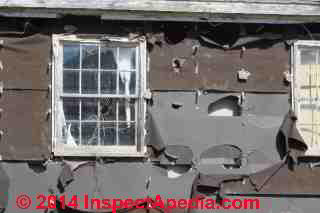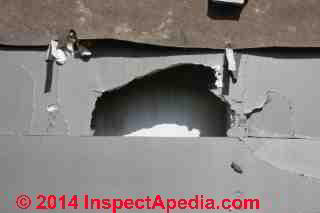 Gypsum Board Building Sheathing FAQs
Gypsum Board Building Sheathing FAQs
- POST a QUESTION or COMMENT about gypsum board sheathing used on building walls & roofs.
Questions & answers about installing or repairing Gyp-rock and other gypsum or plasterboard panels used for building wall & roof sheathing:
Frequently-asked questions about diagnosing and fixing damaged gypsum board exterior wall or roof sheathing, including impact damage, flood damage, or veneer wall damage.
This articleseries describes the use and durability & history of water resistant gypsum panels used in construction of building walls & roofs.
InspectAPedia tolerates no conflicts of interest. We have no relationship with advertisers, products, or services discussed at this website.
- Daniel Friedman, Publisher/Editor/Author - See WHO ARE WE?
Gypsum board building exterior wall sheathing - history, description, age of use
 These questions and answers about repairing veneer walls backed on gypsum board sheathed buildings were posted originally
These questions and answers about repairing veneer walls backed on gypsum board sheathed buildings were posted originally
On 2017-09-25 by Robert Taylor - If a house has the "water repellent" gypsum board sheathing with brick veneer, can the sheathing be dried out and left in place?
by the way, the homes mentioned below just went through the Harvey storm. The homes had about 5 feet of water in them for about 2 weeks. So, can the exterior gyp board sheathing be left in place if it is not completely disintegrated?
If a house has the "water repellent" gypsum board sheathing with brick veneer, can the sheathing be dried out and left in place? To replace it, I see no way to do this without removing the brick.
Otherwise, you will not have a good waterproof membrane behind the brick
. I have recently looked at several brick veneer homes that a contractor has removed interior gypboard, insulation, and the exterior water repellent gypboard sheathing. They left the brick in place. How can you install any sheathing with proper waterproofing from the interior side of the wall with the brick in place? This seems to be impossible to do but has been suggested by FEMA.
[Click to enlarge any image]
On 2017-09-25 by (mod) - repair suggestions for flooded brick veneer over gypsum board sheathing walls
Robert,
Your question is really important - so I appreciate seeing it.
We have discussed what is an almost identical problem on flooded buildings where fiberboard exterior sheathing is installed.
See BRICK VENEER WALL REPAIRS in FLOOD PRONE AREAS where we describe some repair options.
I have indeed found gypsum board sheathed buildings (like ones shown on this page) that had been exposed to the weather and whose gypsum board water-resistant (not waterproof) material was in remarkably good shape.
But none of those cases involved a building whose gypsum board sheathing sat under-water for days or weeks or longer. In those cases it would be smart to remove the flood-damaged gypsum board. That's done by cutting away the gyp-board between the wall studs from the wall's interior side.
Cuts are made along the wall sill plate top, along the sides of the studs, and up to a height at least a foot above the last point of visible damage, wetting, deterioration, or mold. Then cut horizontally across the gypsum board at that height.
Inspect both sides of the gypsum board for visible mold. If you see mold on either side of the top of the last bit you cut out of the wall, working from the floor height upwards, cut another foot out and inspect again. Continue that process until you are confident that the material that remains is intact and not soft (from water damage) and mold free (by visual inspection).
You will be leaving gypsum board between the inner face of the veneer (brick or stone) and the outer or outwards-facing surface of the wall studs. Mold that might be in those spaces will be sealed against entry into the wall cavity and building when the wall cavity has been cleaned, sanitized, dried, and re-insulated (perhaps best using closed cell spray foam).
You will see in our brick veneer wall repair article I cited above that we suggest moving weep openings higher in the wall to just above the highest anticipated flood line - typically that will be the same as the bottom edge of the gypsum board that you are leaving in the wall cavity.
Details are in the article I cited.
Adding to be clear,
at the article we cite you'll see a suggestion for use of closed cell foam insulation that, properly applied, can form a waterproof barrier behind the veneer.
You're dead right that without either a perfect seal or perfect drainage plane behind the veneer we're going to see water problems again on the building.
FEMA's suggestions reported to us here at InspectApedia have been sometimes brilliant, sometimes inconsistent and sometimes frightening or arbitrary - at least in what was reported to me. For example, removing material from a flooded building up to an *arbitrary* height of two feet or four feet above the interior floor could be a serious error - we need to consider the actual depth to which a building was flooded as well as the actual height of damaged materials in and on the walls.
But the bottom line is that it can indeed be possible to preserve the exterior veneer wall and to repair the wall from the interior side.
If the veneer wall is slightly loose or leaning but not buckled it might be repaired by adding wall ties through the veneer to the studs.
if the veneer wall is buckled, cracked, falling, it is unsafe and is probably beyond economical repair.
Use the page top or bottom CONTACT link to send me some exterior and interior photos of the conditions of your home and we can comment further.
On 2016-11-04 by Michael Diamond
Here in Baton Rouge, Louisiana the great flood of 2016 has put a lot of us in a predicament with this 1960 gypsum. Lots of homes had this exterior of the studs with brick venire. Insurance companies are going crazy and sending engineers down here for technical recommendations
. I find it hard to believe there is no consensus standard or best recommended engineering practice utilized by insurance companies on this issue. The recommendations are random and some even borderline insane telling people to cut the studs and remove brick, studs and gypsum.
Any technical recommendations with any standards to support recommendations would be appreciated.
On 2016-05-30 by (mod) -
I've not seen a specification on wetting cycle tolerance; But I would be alert for a mold problem in such a building regardless. I'd like to see details and photos (see the page bottom CONTACT link)
On 2016-05-20 by Chuck D. Fowler
We are studying a situation regarding this sheathing, marked ASTM C79-54 Gypsum water-repellent sheathing on a home constructed in 1970. It has had a few inches of water on the interior floor from floodwater in the past, but recently had 33 inches
. The lower 15-18 inches of interior paper backing has debonded in the sense that a knife-blade can relatively easily be inserted between the paper and gypsum.
There are also differences in sounding audibles in the area above the 33 inch line, and the area below the 33 inch line, although the paper doesn't appear to have debonded at that height, which has only been subject to this last flood.
How many cycles of wetting-drying could this sheathing be exposed to prior to debonding?
On 2016-04-26 by timothy w hughes
I have a black felt like paper covered gypsum board sheeting on my house built in the mid fifties . The siding used over this sheeting was cedar shingles applied with a nail with a curled end . I would like to find out how these nails were applied and how they curled after being driven .
If you try to remove the nails it pulls the sheeting apart . Needless to say it is best to break the shingle and sink the nail head flush with the sheeting .
If your home has been damaged by flooding and is built with an exterior wall covering of brick or stone veneer, see BRICK VENEER WALL REPAIRS in FLOOD PRONE AREAS...
Continue reading at SHEATHING, GYPSUM BOARD or select a topic from the closely-related articles below, or see the complete ARTICLE INDEX.
Or see these
Recommended Articles
- BRICK VENEER WALL REPAIRS in FLOOD PRONE AREAS for a discussion of repair options for brick veneer walls in flood damaged buildings
- BRICK VENEER WALL LEAKS in FLOOD PRONE AREAS - things to do before & immediately after a flood
- DRYWALL, FIBERBOARD, PLASTER INTERIORS
- PLASTER TYPES & METHODS in BUILDINGS
- SHEATHING, EXTERIOR PRODUCT INDEX
- SHEATHING, FIBERBOARD Celotex Homasote & Other
- STUCCO WALL METHODS & INSTALLATION
Suggested citation for this web page
GYPSUM BOARD SHEATHING FAQs at InspectApedia.com - online encyclopedia of building & environmental inspection, testing, diagnosis, repair, & problem prevention advice.
Or see this
INDEX to RELATED ARTICLES: ARTICLE INDEX to ASBESTOS HAZARDS
Or use the SEARCH BOX found below to Ask a Question or Search InspectApedia
Or see
INDEX to RELATED ARTICLES: ARTICLE INDEX to BUILDING INTERIORS
Or use the SEARCH BOX found below to Ask a Question or Search InspectApedia
Ask a Question or Search InspectApedia
Try the search box just below, or if you prefer, post a question or comment in the Comments box below and we will respond promptly.
Search the InspectApedia website
Note: appearance of your Comment below may be delayed: if your comment contains an image, photograph, web link, or text that looks to the software as if it might be a web link, your posting will appear after it has been approved by a moderator. Apologies for the delay.
Only one image can be added per comment but you can post as many comments, and therefore images, as you like.
You will not receive a notification when a response to your question has been posted.
Please bookmark this page to make it easy for you to check back for our response.
IF above you see "Comment Form is loading comments..." then COMMENT BOX - countable.ca / bawkbox.com IS NOT WORKING.
In any case you are welcome to send an email directly to us at InspectApedia.com at editor@inspectApedia.com
We'll reply to you directly. Please help us help you by noting, in your email, the URL of the InspectApedia page where you wanted to comment.
Citations & References
In addition to any citations in the article above, a full list is available on request.
- In addition to citations & references found in this article, see the research citations given at the end of the related articles found at our suggested
CONTINUE READING or RECOMMENDED ARTICLES.
- Carson, Dunlop & Associates Ltd., 120 Carlton Street Suite 407, Toronto ON M5A 4K2. Tel: (416) 964-9415 1-800-268-7070 Email: info@carsondunlop.com. Alan Carson is a past president of ASHI, the American Society of Home Inspectors.
Thanks to Alan Carson and Bob Dunlop, for permission for InspectAPedia to use text excerpts from The HOME REFERENCE BOOK - the Encyclopedia of Homes and to use illustrations from The ILLUSTRATED HOME .
Carson Dunlop Associates provides extensive home inspection education and report writing material. In gratitude we provide links to tsome Carson Dunlop Associates products and services.

